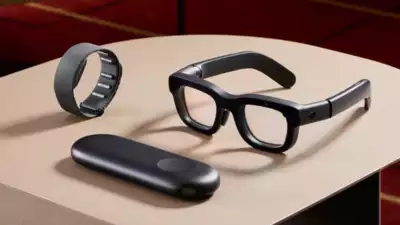
Orion AR glasses
Mark Zuckerberg’s vision for augmented reality (AR) is steadily becoming reality with Meta’s latest innovation: Orion AR glasses.
These revolutionary glasses are more than just a sneak peek into future technology. Notably, they’re part of Zuckerberg’s broader ambition to replace smartphones with wearable devices that integrate the virtual world with the physical.
Though Meta’s Orion glasses are still a prototype and not yet available to the public. However, they offer a glimpse into how AR will shape our daily lives in the coming years.
The Evolution of Orion AR Glasses
The development of Orion glasses has been a focal point in Zuckerberg’s tech strategy for some time. Since acquiring Oculus VR and expanding Meta’s AR/VR initiatives, Zuckerberg has often spoken about AR glasses as the “holy grail” of personal devices. His vision for these glasses is clear: a world where AR glasses seamlessly replace smartphones as the primary gateway to the digital world.
Orion AR glasses were initially projected to hit the consumer market by 2024. However, this timeline changed due to significant production costs and technical challenges. The silicon carbide lenses used in Orion, a key feature for AR immersion, are expensive and complex to produce. Hence with each pair Orion AR glasses estimated to cost around $10,000. As a result, Meta has shifted its focus toward refining the technology, showcasing prototypes rather than launching a commercial product.
What Makes Orion Glasses Stand Out?

Unlike other AR glasses on the market, Orion aims to offer a truly immersive experience. Built in three parts, the Orion system includes the glasses themselves, a neural wristband for control, and a compute puck for offloading tasks to improve battery life and reduce heat. Each part of the system is designed to work together, creating an integrated AR experience that is intuitive and responsive.
The glasses themselves feature a 70-degree field of view, much wider than most AR glasses currently available. This wider field of view enhances the sense of immersion, allowing virtual objects to fill more of the user’s vision without needing to focus on a specific point. This is further amplified by ULED projectors embedded in the frame. Notably, which beam graphics into the user’s field of vision through wave guides in the lenses.
The neural wristband, one of the standout features, is a game-changer for AR interactions. The wristband uses electromyography (EMG) to interpret neural signals from the user’s fingers, translating these signals into commands for the glasses. A simple pinch of the fingers can select an item, while swiping gestures control scrolling. This novel approach to interaction eliminates the need for controllers or touchpads, making the AR experience far more intuitive.
Finally, the compute puck is responsible for processing complex tasks that would otherwise drain the battery or overheat the glasses. This small, wireless device offloads app logic, ensuring that the glasses remain lightweight and comfortable to wear for extended periods.
A Day in the Life with Orion AR Glasses
While the technology is still in its early stages, the demo provided by Meta offers a compelling look at how Orion could be used in everyday life. During the demo, users were able to browse the web, make video calls, play games, and even prepare a smoothie using Meta’s AI assistant. The glasses identified the ingredients for the smoothie, then displayed a recipe and step-by-step instructions in the user’s field of view.

One of the most intriguing features was the ability to interact with Meta AI. By simply asking the assistant for a recipe, users could see how AR and AI might intersect in practical ways, such as assisting with cooking or other hands-free tasks. The seamless integration of real-world objects with digital information is the hallmark of AR, and Orion’s demo showed just how powerful this combination could be.
Additionally, the glasses’ ability to anchor virtual objects in the physical world is impressive. For instance, users could leave a window open in the virtual space, walk away, and return to find it still in the same spot. This sense of spatial awareness is a key part of Meta’s long-term AR strategy.
The Challenges Ahead
While Orion AR glasses represent an exciting leap forward, they also highlight the challenges Meta faces in bringing AR to the masses. The first major hurdle is cost. At present, the glasses are prohibitively expensive to produce, with each pair costing around $10,000. Until Meta can reduce production costs, a consumer launch remains unlikely.
Another challenge is perfecting the software. Although the demo showcased some impressive features, it was clear that the software is still in its early stages. During the demo, for instance, incoming video calls sometimes obstructed the user’s view, creating a jarring experience. These issues need to be resolved before AR glasses can become a viable replacement for smartphones.
Additionally, user comfort and battery life are critical concerns. The glasses must be light and comfortable enough to wear for extended periods without overheating or running out of battery. The addition of the compute puck helps alleviate these issues, but further advancements are necessary.
What’s Next for Meta and AR?
Despite these challenges, Meta is pushing forward with its AR initiatives. The company has produced about 1,000 Orion units for internal prototyping, showcasing them at industry events and through select demos. Though the glasses are not available for purchase, they are a clear indicator of where Zuckerberg wants to take Meta and the tech world as a whole.
Zuckerberg’s bet on the Metaverse and AR is massive, and Orion glasses are a key component of that vision. While the timeline for commercial release is still unclear, Meta’s focus on refining the technology suggests that AR glasses could become a central part of our lives in the near future.
As Meta continues to innovate, the world will be watching closely to see how Orion evolves. With the potential to replace smartphones and revolutionize the way we interact with digital information, these AR glasses could mark the beginning of a new era in personal technology. For now, Orion remains a prototype, but it won’t be long before AR glasses become as common as the smartphones we use today.





